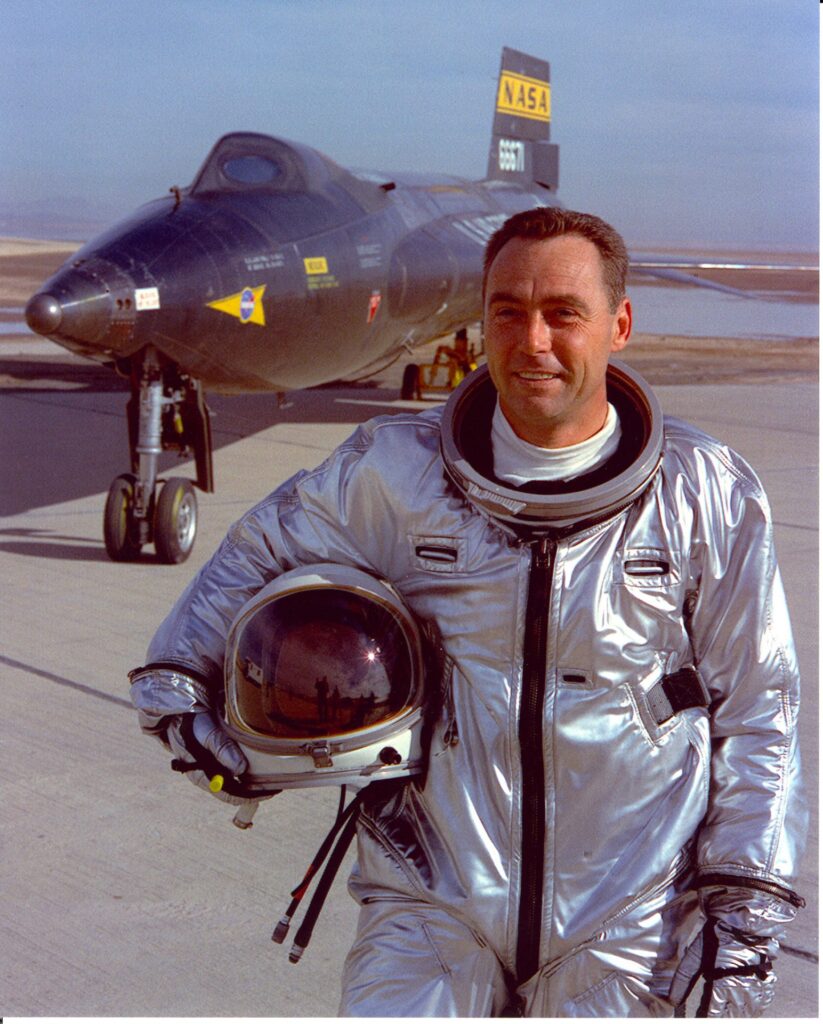William Joseph “Pete” Knight was born in Noblesville, Indiana on November 28, 1929. After working as a racehorse jockey, he enlisted in the U.S. Air Force in 1951, and upon receiving his commission through the aviation cadet program, completed pilot training in 1953. Flying an F-89D for the 438th Fighter-Interceptor Squadron, Knight won the prestigious Allison Jet Trophy Race in September 1954.
After receiving a Bachelor of Science degree in Aeronautical Engineering from the Air Force Institute of Technology at Wright-Patterson Air Force Base, Ohio in 1958, Pete Knight attended the U.S. Air Force Test Pilot School at Edwards Air Force Base, California, graduating later that same year. He remained at Edwards as project test pilot on the F-100, F-101, F-104, and, later, T-38 and F-5 test programs.
In 1960, Knight was one of six test pilots selected to fly the X-20 DynaSoar. The Air Force planned to make this the first winged orbital space vehicle capable of lift-offs, reentries and conventional landings. When the X-20 program was canceled in 1963, he completed the astronaut-training curriculum at the new U.S. Air Force Aerospace Research Pilot School at Edwards in 1964. On October 12, 1965, he flew the X-15 experimental rocket plane for the first time.
While flying an X-15 at 107,000 feet at speeds of Mach 4.17 on June 29, 1967, Knight’s vehicle suffered a total electrical failure and all onboard systems shut down. He arched up to 173,000 feet, then set up a visual approach and glided to a safe emergency landing at Mud Lake, Nevada. For this feat he earned a Distinguished Flying Cross.
On October 3, 1967, he piloted the modified X-15A-2 to a speed of 4,520 mph (Mach 6.7) the highest speed ever attained in a fixed-wing aircraft. During sixteen flights in the rocket plane, Knight also became one of only eight pilots to earn astronaut’s wings by flying an airplane into “technical” space when he climbed to 280,500 feet on October 17, 1967. He is credited with ten minutes in space for this flight.
After nearly ten years of test flying at Edwards Air Force Base Knight transferred to Southeast Asia in 1968 where he flew 253 combat missions in the F-100. Following his combat tour, he served as test director for the F-15 System Program Office at Wright-Patterson Air Force Base, Ohio. In this capacity, he became just the tenth pilot to fly the F-15 Eagle and completed some of the initial evaluations of the fighter. Following an assignment as Director of the Fighter Attack System Program Office, he returned to Edwards as vice commander of the Air Force Flight Test Center in 1979. He also remained an active test pilot in the F-16 Combined Test Force.
After 32 years of service and more than 7,000 hours in the cockpits of more than 100 different aircraft, Knight retired from the U.S. Air Force in 1982 with the rank of Colonel. During his military career, Colonel Knight was awarded the Legion of Merit with one Oak Leaf Cluster, the Distinguished Flying Cross with two Oak Leaf Clusters; the Air Medal with ten Oak Leaf Clusters, the Harmon International Trophy, the Octave Chanute Award, and the Air Force Association Citation of Honor.
In 1984, Pete Knight was elected to the city council of Palmdale, California, and, four years later became the city’s first elected mayor. In 1992, Colonel Knight was elected as a Republican to the California State Assembly representing the 36th District and, in 1996, was elected Republican state senator representing California’s Seventeenth Senate District. He remained in the legislature until his death in Duarte, California on May 8, 2004.

